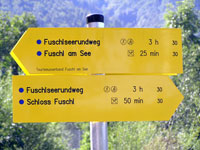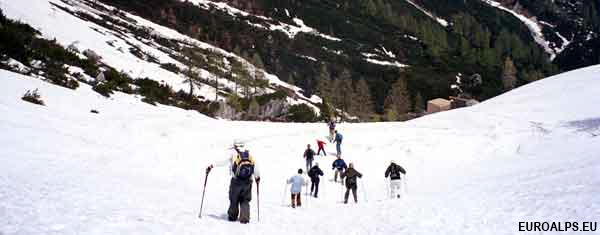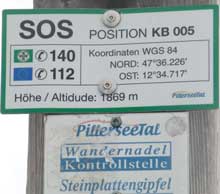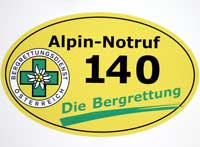Walking Austria's Alps: Hut to Hut
Jonathan Hurdle Eleven treks in the Austrian alps ranging from four to eleven days in length, with nightly stops at a mountain hut. No climbing skill or equipment is necessary.
Eleven treks in the Austrian alps ranging from four to eleven days in length, with nightly stops at a mountain hut. No climbing skill or equipment is necessary.
Mountain Walking in Austria
Cecil Davies A Guide to 98 walks in 25 Mountain Groups in the Eastern Alps.
A Guide to 98 walks in 25 Mountain Groups in the Eastern Alps.
Walking in the Alps
(Lonely Planet Walking Guides) This walking guide covers the best walks through the Alps in France, Italy, Switzerland, Austria, Germany and Slovenia. Practical advice on language, gear, safety, food and accommodation are also included.
This walking guide covers the best walks through the Alps in France, Italy, Switzerland, Austria, Germany and Slovenia. Practical advice on language, gear, safety, food and accommodation are also included.
Walks & Hikes in the European Alpine Region
Walking in Filzmoos in May, near Hofpürglhütte

A lot of footpath signs in Austria now conform to the standard shown here
Types of Alpine Walks and Hikes
- Day walks. These take a day and can either return to the same base (hotel) or can travel to another base.
- If you move to a different base each day you can explore a larger / different area but it may cost more as you only stay one night at each base. You also need to either arrange for your luggage to be transported or you will need to carry it all. An example of this would be a hut to hut tour.
- If you don't want to plan your own walk you can go on a led walk. Most resorts offer led or guided walks. There are several companies that offer guided walking holidays.
Depending on the resort, the terrain can vary from populated wide valleys to steep remote peaks. Most paths will be way marked with signposts showing destinations and possibly also the walking times. There may also be painted marks on rocks or trees. Keep on the marked paths. You may see signs with information about the area or describing the path. You may see “nur für geübte”- German “only for experienced”; “Klettersteig” (German) or “Via Ferratta” (Italian) - fixed ropes or ladders. Watch out for falling stones or rocks if you see “Vorsicht Steinschlag” - German “Caution falling rocks”.
To a certain extent the resort will determine the type and range of walking or hiking available. Resorts in Switzerland and western Austria tend to lie in steeper “V” shaped valleys while resorts in eastern Austria lie in “U” shaped valleys.
You may be able to buy maps and guidebooks in the resort but supplies may be limited, may not be available in English and you will need to spend some time finding them. By getting them before you leave you will also be able to study the area and ensure that you choose an appropriate resort / area.
See the resort map page for details of suitable maps for that area.
If you plan on strenuous hikes or walks get some practice in before your holiday.
Make sure that you have travel insurance that covers you for any injuries you may have when you are walking. If you need to be rescued by helicopter you may have to pay some or all of the cost. This not only applies to remote hikes in the mountains but also gentle rambles in the hills when you could still be a distance from roads.
Consider going on a course if you want to go on hikes involving mountain hiking / climbing for the first time. A basic navigation course involving map and compass is also useful for all types of walking or hiking.
Take suitable clothes and walking gear with you. What you take will depend on the type of walking you plan to do and the time of the year. A mobile phone and GPS receiver can be useful.
You need to remember that you may need some time to acclimatise to the altitude – some resorts, like Obergurgl Austria (1930 metres), are at a high altitude and the walks in the mountains will be even higher. Start off on the first day with an easier walk.
Plan your route carefully before you set out using your maps and guidebooks. Check that you will have enough time without rushing – remember to take into account all members of your party – children may not be able, or want, to go as far as you.
Ask for advice from the hotel of tourist office and make sure that any transport like trains and buses are running. Some resorts have a local “walkers' bus” that will enable you to go to more remote areas.
Remember to take enough food and drink with you. Some hotels can provide packed or picnic packs. Most resorts have supermarkets or shops where you can buy snacks and drinks. They may also make up rolls if you ask. Make sure you pack it in your rucksack carefully. Take enough drinks with you – you will need more than you might expect to avoid headaches and dehydration. Water is better than fizzy drinks. You can take some Isotonic drinks - some are in powder form which you mix with water, avoid ones with caffeine. Check with the hotel that the tap water is drinkable.
If you plan to stop at a restaurant or café of one of the mountain huts, check that it will be open. Some only open during the main summer season or at weekends. A lot close for one day a week.
- Check weather forecasts (snow, thunder) before you leave and adjust the walk if necessary.
- Before you start remember to leave details of you route and expected time of return.
- Take suitable clothes, equipment, food and drink to cope with the unexpected.
- Keep to marked paths.
- Unless you are going on popular paths with other people around, don't walk alone.
- Be careful of the dangers of rock falls, avalanches.
- If there are problems, return. Things may get worse if you continue.
- Make sure you know what to do in an emergency.
If you need help in an emergency, give a signal (whistle, torch) 6 times in a minute (1 every 10 seconds). Wait a minute then repeat. The reply to acknowledge your signal is 3 signals in a minute.
Most areas have a mountain emergency telephone number or you can use the European emergency number of 112.
In Austria the mountain rescue (Die Bergrettung) emergency telephone number (Alpin Notruf) is 140.
Bergrettungsdienst gives useful information.
If someone needs to go to get help, leave someone with the injured person (this is where walking by yourself can be a problem).

Walking in the Salzkammergut:
Holiday Rambles in Austria's Lake District
Fleur & Colin Speakman This 104 page guide is in English and has maps, routes and background information.
This 104 page guide is in English and has maps, routes and background information.
Walking Easy in the Swiss & Austrian Alps
Chet & Carolee Lipton This US book covers day walks in Alpbach, Kitzbühel, Neustift, Seefeld, Wagrain, Zell Am Ziller, Bad Gastein, Zell am See, Kaprun, Wengen, Grindelwald, Mürren, Meiringen, Lenk, Adelboden, Lötschental, Lucerne, Saas-Fee, Engadine, Zermatt, Arosa, Appenzellerland,
This US book covers day walks in Alpbach, Kitzbühel, Neustift, Seefeld, Wagrain, Zell Am Ziller, Bad Gastein, Zell am See, Kaprun, Wengen, Grindelwald, Mürren, Meiringen, Lenk, Adelboden, Lötschental, Lucerne, Saas-Fee, Engadine, Zermatt, Arosa, Appenzellerland,
There is also a chapter on getting to and about Austria & Switzerland, what to take, and information about Austria & Switzerland.
“Walking Easy in the Austrian Alps”
Chet & Carolee Lipton This US book covers day walks in Alpbach, Damüls, Kitzbühel, Neustift, Seefeld, Tschagguns - Schruns, Wagrain, Zell Am Ziller, Wien (Vienna). Walks are graded as ”Gentle”, “Comfortable”, and ”More Challenging”.There is also a chapter on getting to and about Austria, what to take, and information about Austria.
This US book covers day walks in Alpbach, Damüls, Kitzbühel, Neustift, Seefeld, Tschagguns - Schruns, Wagrain, Zell Am Ziller, Wien (Vienna). Walks are graded as ”Gentle”, “Comfortable”, and ”More Challenging”.There is also a chapter on getting to and about Austria, what to take, and information about Austria.
Navigation Techniques & Skills for Walkers
Pete Hawkins A Guide to map & compass navigation including GPS & digital maps.
A Guide to map & compass navigation including GPS & digital maps.
Walking in the Alps:
A Comprehensive Guide to Walking and Trekking Throughout the Alps
Walking in the Alps
Two books, same name. One by Lonely Planet and one by Kev Reynolds / Cicerone Press.

Steinplattengipfel, Waidring
Emergency Information sign with location & phone numbers

There are lots of walks and hikes that you can do in the European Alpine Regions.
Areas and resorts with descriptions of walks and hikes can be found here together with general walking and hiking advice.
© 2005-2025
A Fielding
All Rights Reserved
|
|
| Subscribe to Hiking Alps |
| Visit this group |
